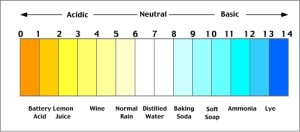The human body is largely made up of water equaling 50-60% of our total body weight. The water is significant as it provides the medium for transferring nutrients, oxygen and bio chemicals from place to place, thus having a profound effect on body chemistry, health and/or disease.
Our body fluids can have either acid or alkaline properties which are measured by a pH scale [potential hydrogen]. 7.0 is considered neutral on a gradient of 1-14. Lower pH levels mean greater acidity and the higher pH, the greater the alkalinity.
The optimal pH of the blood is established at 7.4, slightly alkaline. The body is in a constant battle to maintain appropriate pH levels- too acidic means the body has to work extra hard to expel excess acidic waste- too alkaline creates low electrolyte levels that weaken muscles and nerve functions.
Salivary pH is generally more acidic than blood being in the range of 6.4-6.8 in the resting state. After eating, salivary pH should rise to 7.8 or higher.
Every time we eat foods that contain refined sugar [sucrose] the bacteria in our mouths receive energy allowing them to multiply and produce acids as part of their metabolic process. This may result in the pH falling to below 5.5. At this pH, the enamel of your teeth begins to demineralize and lose its structure – if the process is allowed to continue, it results in tooth decay. When acid first starts to dissolve in your mouth, a white spot appears on the enamel. It is still possible at this stage with help from minerals in your saliva for the tooth to fix itself and remineralize.
Each time you eat a fermentable carbohydrate [foods that break down into simple sugars] the acid remains in your mouth for several hours. People who sip soft drinks or sweetened coffee or who snack on cookies, candies and/or cake all day are at a high risk to develop cavities.
 can be done to keep the pH of the saliva closer to neutral? Diet is a major factor. Here is a list of the approximate pH of some common foods and beverages:
can be done to keep the pH of the saliva closer to neutral? Diet is a major factor. Here is a list of the approximate pH of some common foods and beverages:
Apples 3.9 Lemon juice 2.3
Bananas 5.0 Milk 6.6
Beer 4.0 Orange juice 3.6
Bread 5.6 Peanut Butter 6.3
Cheese 5.9 Soft drinks 3.0
Coffee 5.0 Tomatoes 4.6
Ketchup 3.9 Wine 3.4
Chewing gum with xylitol will reduce the number of acid producing bacteria and raise the pH level in the dental plaque. When it goes above 7, calcium and phosphate salts in the saliva will begin to remineralize the enamel.

